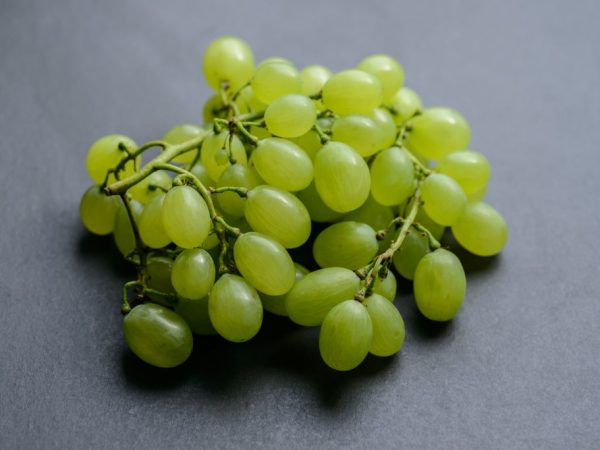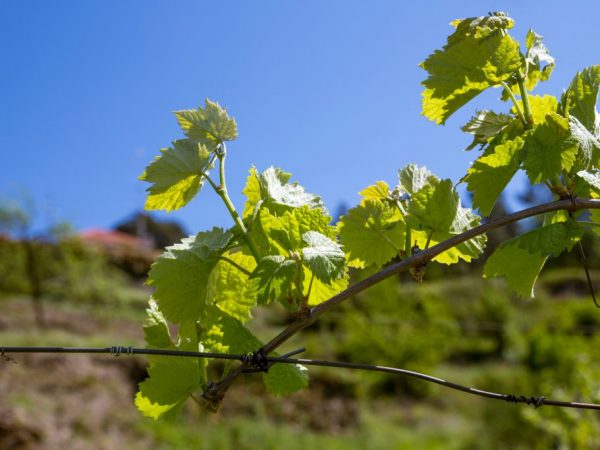Growing grapes Daria
Daria grapes are one of the most popular varieties of domestic selection. It is preferred to grow because of its high yield and beautiful appearance. This variety is unpretentious to care for and bears fruit annually.

Growing grapes Daria
External characteristics of the variety
The popular Daria grapes are characterized by the following appearance features:
- the bush grows up to 3 m high;
- fruiting of shoots is observed at the level of 6 eyes;
- leaves of a rich green color;
- flowers of a light green hue;
- berries are large, weighing up to 20 g;
- the surface of the fruit is covered with a waxy bloom;
- the color of the berries is light brown;
- the weight of a single hand is 1-1.5 kg.
According to the description, the Daria grape variety is characterized by a pleasant taste with hints of nutmeg. The inner bones are small, they contain about 3-5 pieces. Bunches of grapes are stored for a long time and are characterized by a pleasant presentation.
Dasha variety
Dasha grape variety was developed in Ukraine in early 1991. It is characterized by early ripening: 80 days after flowering. After grafting, the shoots quickly take root.
The height of the bush is 2-3 m. Each leaf consists of 5 lobes, at its end there is a sharp tip. The inflorescences are represented by hybrid flowering (stamens are female, and the pistil is male). Disease resistance is average.
The berries are large, oval in shape. According to the description, they have a light green color, they are covered with a dense layer of wax plaque. The bunch is cone-shaped. The weight of 1 berry is 20 g, each bunch weighs up to 1.5 kg. The taste of Dasha berries is pleasant, sweet. There is a slight nutmeg aroma.
Variety Dashun
Dashunya grapes belong to the product of M. Krainov's selection. The bush is high, up to 3 m. The shoots are powerful, therefore they quickly acquire the structure of a tree. The plant begins to bear fruit 2 years after planting. Vegetation lasts 100 days.
The berries of the Dashun variety reach a weight of 25 g and have an oval shape. The weight of the conical bunch is 1.5 kg. Berries of a deep red hue, covered with a waxy bloom.
The pulp of Dashunya berries is dense. The aroma and taste have notes of nutmeg, so a delicious wine is obtained from the variety.
Growing grapes

The plant needs sunlight
Before planting, determine the correct location for the grape crop. The site should be well lit by sunlight. The speed and quality of the harvest depends on this. To protect Dashenka grapes from the wind, they are planted from the south side of the house, near the barriers.
When choosing a soil, preference is given to fertile lands. For better fruiting, several buckets of compost and humus are introduced into the soil for each square meter. The soil must be equipped with a drainage system to regulate the flow of moisture.
Grapes are planted in early spring, but after winter frosts. It is better to do this at the end of March.
Landing in the soil
The method of planting in soil depends on the type of land. It is carried out into sandy soil by trenches. In loamy soils or chernozems, planting is carried out on raised beds. To begin with, dig a small hole. Its size depends on the development of the root system. Saplings are set at a steep angle. This allows the plant to develop faster and the vine to ripen.
The roots are sprinkled with earth tightly and tamped a little. At the end of planting, each bush is watered with 10 liters of warm water so that it takes root faster. Planting scheme for Dashenka series crops - 1.5 x 2 m.
Plant care
The plant needs quality care. Planting is carried out in open, unshaded areas, because optimal fruiting conditions are observed at the right temperature. The plant feels good at 25 ° C-27 ° C during the day and 14 ° C-18 ° C at night.
Irrigation rules
Watering is carried out in the morning or evening using warm water. At least 10-15 liters are poured under each plant. After watering, the soil is loosened and weeds that retard the development of the bush are removed. The watering interval is 20 days. In the phase of flower and fruit formation, the interval is reduced to 10 days.
Top dressing
Fertilizers are applied several times during the entire growing season. Description of the procedure:
- During the period of intensive growth, 20 liters of potassium nitrate solution (30 g per 10 liters of water) are poured under the bush.
- At the flowering phase, add 15 liters of superphosphate solution (50 g per 10 liters of water).
- At the time of fruiting, at least 20 liters of ammonium nitrate solution (50 g per 10 liters of water) are poured under each grape bush.
The need for pruning
Pruning of bushes is carried out in the spring. All damaged shoots and dry branches are removed. Each should have no more than 5 eyes.
The antennae are also subject to removal. For the winter, the plants are covered with agrofibre or foil to protect them from frost.
Diseases and pests
Plants of the Dashenka variety are often affected by gray rot, mildew and powdery mildew. A solution of Bordeaux liquid (3 g per 10 liters of water) helps to get rid of gray rot. In the fight against mildew and oidium, spraying with a solution of homa (30 g per 10 l of water) is used.
Of the pests of the plant, only aphids are affected. Oxychoma solution (50 g per 10 l of water) helps to effectively fight it. Spraying is carried out at intervals of 10 days.
As a preventive measure, care procedures are followed: weeding and loosening of the soil are carried out on time. Spraying the bushes with copper sulfate increases the plant's resistance to diseases and pests.
Conclusion
The varieties Dasha, Dashunya and Daria were bred in different regions of the USSR. All of them are characterized by good yield and presentation. Every gardener, even a beginner in this field, will collect quality products if he follows simple rules for growing these varieties.


